



生物多样性 ›› 2024, Vol. 32 ›› Issue (4): 23419. DOI: 10.17520/biods.2023419 cstr: 32101.14.biods.2023419
收稿日期:2023-11-06
接受日期:2024-02-27
出版日期:2024-04-20
发布日期:2024-03-28
通讯作者:
* E-mail: 基金资助:
Mengyao Zheng, Yuan Li, Xuerong Wang, Yue Zhang, Tong Jia*( )
)
Received:2023-11-06
Accepted:2024-02-27
Online:2024-04-20
Published:2024-03-28
Contact:
* E-mail: 摘要:
原生动物是土壤微生物群落的重要组成部分, 在生态系统中扮演着分解者和还原者的双重角色, 担负着维持生态系统平衡、健康以及能量流动枢纽等重要功能。研究不同植被类型下土壤原生动物群落特征及其构建过程, 对认识各类生态系统中原生动物群落多样性维持机制及加强生物多样性保护有重要意义。本研究以芦芽山森林、灌丛、草地土壤为研究对象, 采用高通量测序技术, 探究不同植被类型下原生动物群落组成、多样性及构建机制。结果表明: 芦芽山不同植被类型土壤原生动物群落分属于9界、23门、58纲、117目、215科、335属和1,979个可操作性分类单元。芦芽山土壤原生动物群落的α多样性在森林与草地、灌丛间没有显著差异。不同植被类型的原生动物群落结构具有差异。冗余分析结果发现, 土壤总磷和含水量是决定不同植被类型原生动物群落结构的重要环境因子。零模型结果表明, 芦芽山3种植被类型土壤原生动物群落构建过程均以随机性过程占主导。分子生态网络分析显示, 土壤原生动物群落的复杂性从高到低依次为草地、灌丛和森林。研究结果揭示了影响芦芽山森林、草地和灌丛土壤原生动物群落在物种组成和多样性的关键生态因子, 初步探明不同植被类型土壤原生动物群落的复杂性及其构建机制, 为深入了解土壤各营养级生物类群落的相互关系及其构建机制提供理论依据和数据支持。
郑梦瑶, 李媛, 王雪蓉, 张越, 贾彤 (2024) 芦芽山不同植被类型土壤原生动物群落构建机制. 生物多样性, 32, 23419. DOI: 10.17520/biods.2023419.
Mengyao Zheng, Yuan Li, Xuerong Wang, Yue Zhang, Tong Jia (2024) Soil protozoa community assembly mechanism in different vegetation types of Luya Mountain. Biodiversity Science, 32, 23419. DOI: 10.17520/biods.2023419.
| 植被类型 Vegetation type | 地理位置坐标 Geographic coordinates | 海拔 Altitude (m) | 坡向 Aspect | 坡度 Slope |
|---|---|---|---|---|
| 草地 Grassland | 111°50′ E 38°43′ N | 2,750 | 南坡 South slope | 0° |
| 灌丛 Shrub | 111°50′ E 38°43′ N | 2,750 | 南坡 South slope | 0° |
| 森林 Forest | 111°54′ E 38°44′N | 2,280 | 半阴坡 Semi-shady slope | 9.8° |
表1 芦芽山采样点信息
Table 1 The information of sampling sites in Luya Mountain
| 植被类型 Vegetation type | 地理位置坐标 Geographic coordinates | 海拔 Altitude (m) | 坡向 Aspect | 坡度 Slope |
|---|---|---|---|---|
| 草地 Grassland | 111°50′ E 38°43′ N | 2,750 | 南坡 South slope | 0° |
| 灌丛 Shrub | 111°50′ E 38°43′ N | 2,750 | 南坡 South slope | 0° |
| 森林 Forest | 111°54′ E 38°44′N | 2,280 | 半阴坡 Semi-shady slope | 9.8° |
| 植被类型 Vegetation type | 土壤含水量 SWC | pH | 总氮 TN (g/kg) | 总碳 TC (g/kg) | 总磷 TP (g/kg) | 硝态氮 NO3--N (mg/kg) | 氨态氮 NH4+-N (g/kg) |
|---|---|---|---|---|---|---|---|
| 草地 Grassland | 2.75 ± 0.29b | 6.53 ± 0.28a | 4.88 ± 0.57b | 53.49 ± 5.56a | 0.96 ± 0.43a | 1.23 ± 0.43a | 31.65 ± 4.51a |
| 灌丛 Shrub | 3.75 ± 0.17ab | 6.71 ± 0.27a | 5.80 ± 0.78a | 64.36 ± 9.25a | 0.83 ± 0.12b | 1.24 ± 0.46a | 24.91 ± 3.33b |
| 森林 Forest | 5.32 ± 2.29a | 6.51 ± 0.18a | 3.41 ± 0.62c | 57.57 ± 13.49a | 0.64 ± 0.07c | 1.14 ± 0.08a | 32.96 ± 4.30a |
表2 不同植被类型土壤的理化性质
Table 2 Physical and chemical properties of soils in different vegetation types
| 植被类型 Vegetation type | 土壤含水量 SWC | pH | 总氮 TN (g/kg) | 总碳 TC (g/kg) | 总磷 TP (g/kg) | 硝态氮 NO3--N (mg/kg) | 氨态氮 NH4+-N (g/kg) |
|---|---|---|---|---|---|---|---|
| 草地 Grassland | 2.75 ± 0.29b | 6.53 ± 0.28a | 4.88 ± 0.57b | 53.49 ± 5.56a | 0.96 ± 0.43a | 1.23 ± 0.43a | 31.65 ± 4.51a |
| 灌丛 Shrub | 3.75 ± 0.17ab | 6.71 ± 0.27a | 5.80 ± 0.78a | 64.36 ± 9.25a | 0.83 ± 0.12b | 1.24 ± 0.46a | 24.91 ± 3.33b |
| 森林 Forest | 5.32 ± 2.29a | 6.51 ± 0.18a | 3.41 ± 0.62c | 57.57 ± 13.49a | 0.64 ± 0.07c | 1.14 ± 0.08a | 32.96 ± 4.30a |
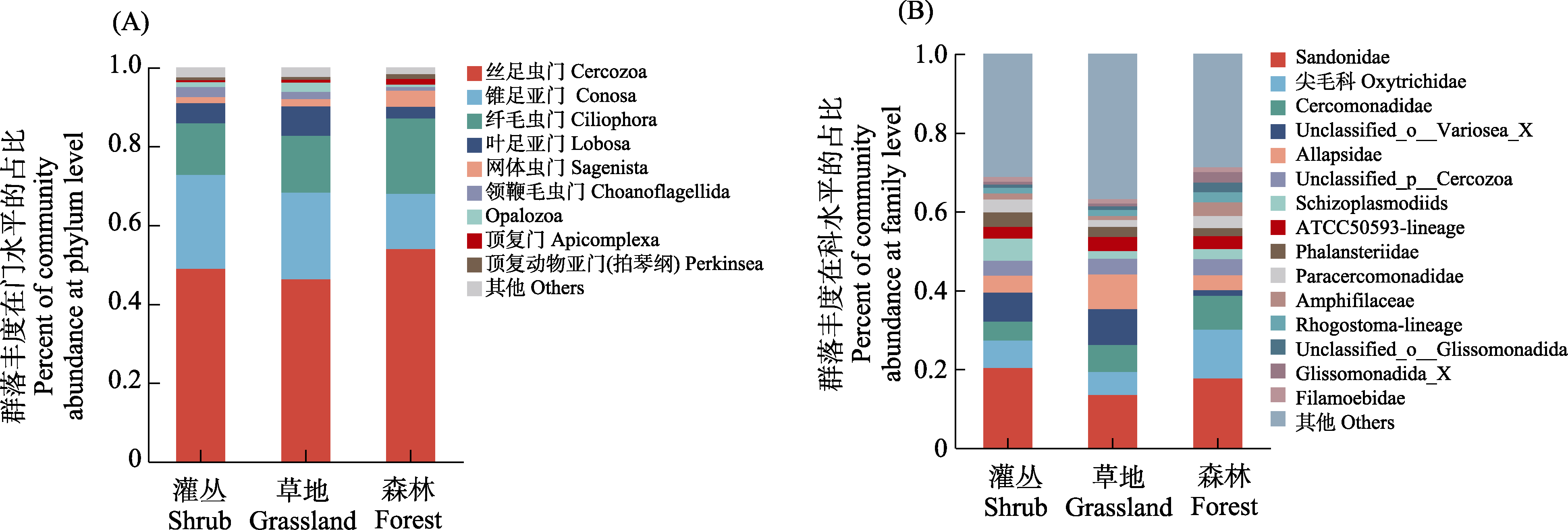
图1 不同植被类型原生动物群落组成。(A)优势门(相对丰度 > 1%); (B)优势科(相对丰度前15)。
Fig. 1 Analysis of protozoan community composition among different vegetation types. (A) Dominant phylum (relative abundance > 1%); (B) Dominant family (relative abundance of top 15).
| 植被类型 Vegetation type | OTUs Operational taxonomic units | Shannon-Wiener指数 Shannon-Wiener index | Simpson指数 Simpson index | Chao指数 Chao index | 覆盖度指数 Coverage index |
|---|---|---|---|---|---|
| 草地 Grassland | 436.8 ± 32.175b | 4.879 ± 0.196a | 0.018 ± 0.048a | 522.537 ± 37.424b | 0.995 ± 0.006a |
| 灌丛 Shrub | 440.2 ± 127.095b | 4.747 ± 0.288a | 0.021 ± 0.059a | 538.556 ± 172.994b | 0.993 ± 0.003a |
| 森林 Forest | 576.2 ± 57.430a | 5.002 ± 0.225a | 0.017 ± 0.035a | 714.402 ± 77.434a | 0.990 ± 0.002b |
表3 不同植被类型原生动物群落的丰富度和多样性(平均值 ± 标准误)
Table 3 Abundance and diversity of protozoan communities in different vegetation types (mean ± SE)
| 植被类型 Vegetation type | OTUs Operational taxonomic units | Shannon-Wiener指数 Shannon-Wiener index | Simpson指数 Simpson index | Chao指数 Chao index | 覆盖度指数 Coverage index |
|---|---|---|---|---|---|
| 草地 Grassland | 436.8 ± 32.175b | 4.879 ± 0.196a | 0.018 ± 0.048a | 522.537 ± 37.424b | 0.995 ± 0.006a |
| 灌丛 Shrub | 440.2 ± 127.095b | 4.747 ± 0.288a | 0.021 ± 0.059a | 538.556 ± 172.994b | 0.993 ± 0.003a |
| 森林 Forest | 576.2 ± 57.430a | 5.002 ± 0.225a | 0.017 ± 0.035a | 714.402 ± 77.434a | 0.990 ± 0.002b |
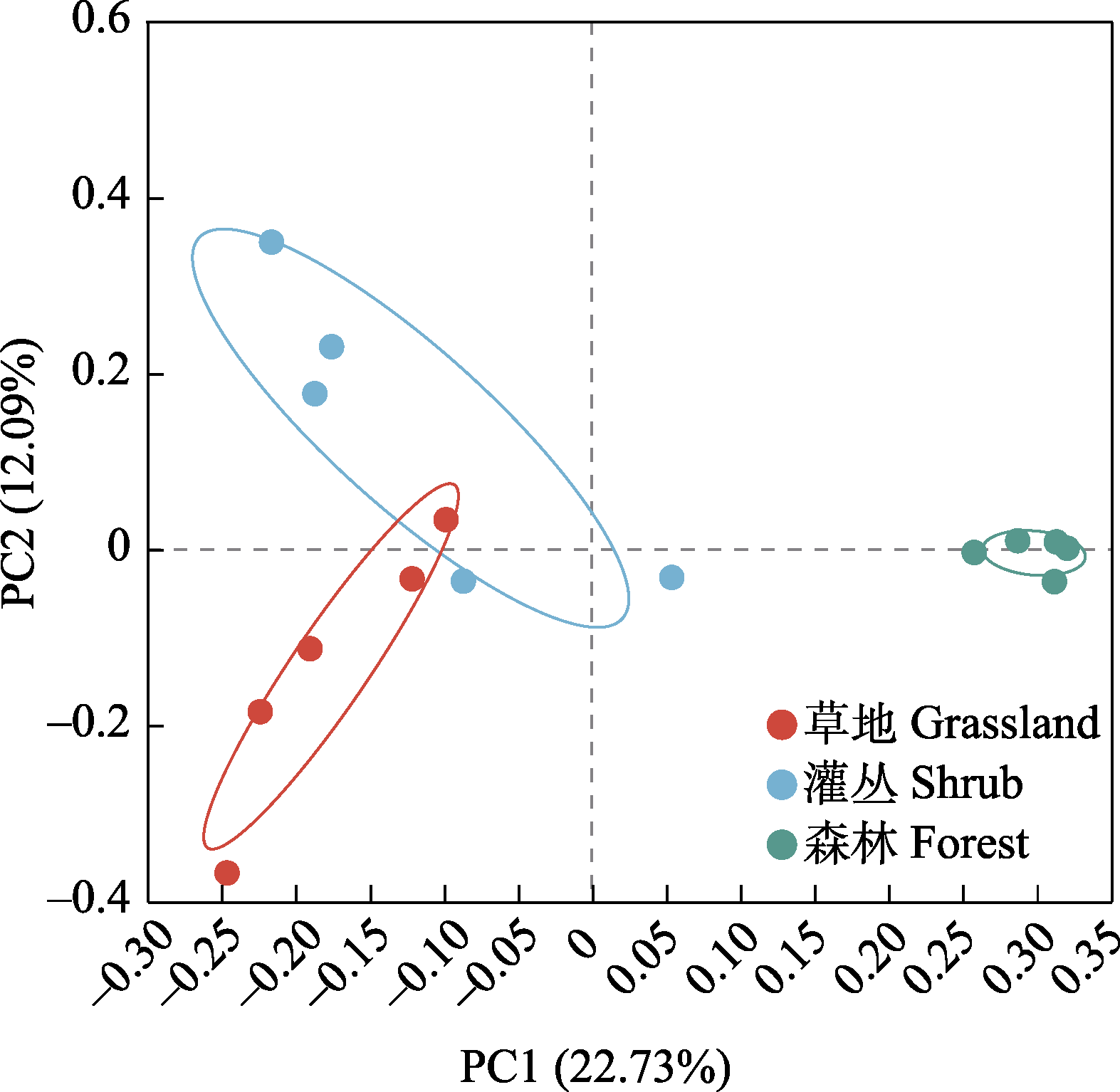
图2 基于Bray-Curtis距离的不同植被类型土壤原生动物群落主坐标分析(PCoA)
Fig. 2 Principal coordinates analysis (PCoA) of soil protozoan communities in different vegetation types based on Bray-Curtis distance
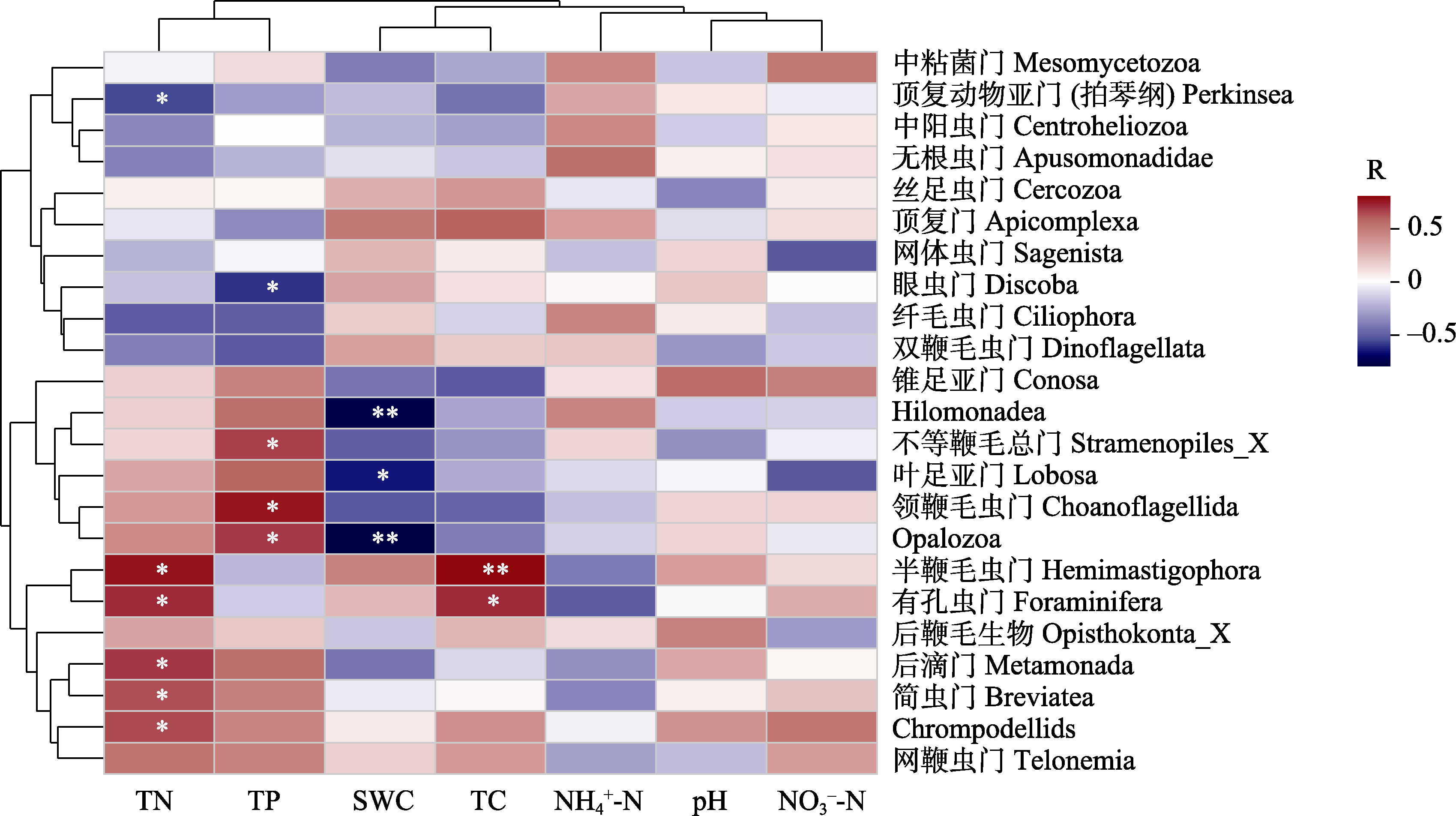
图3 基于门水平的不同植被类型土壤原生动物群落与环境因子的关系。SWC: 土壤含水量; TC: 总碳; TN: 总氮; TP: 总磷; NO3--N: 硝态氮; NH4+-N: 铵态氮。X轴和Y轴分别为环境因子和物种, R表示相关系数。* P < 0.05, ** P < 0.01。
Fig. 3 The relationship between soil protozoan community and environmental factors in different vegetation types based on phylum level. SWC, Soil water content; TC, Total carbon; TN, Total nitrogen; TP, Total phosphorus; NO3--N, Nitrate nitrogen; NH4+-N, Ammonium nitrogen. X- and Y-axes are environmental factors and species, respectively. R denotes the correlation coefficient.
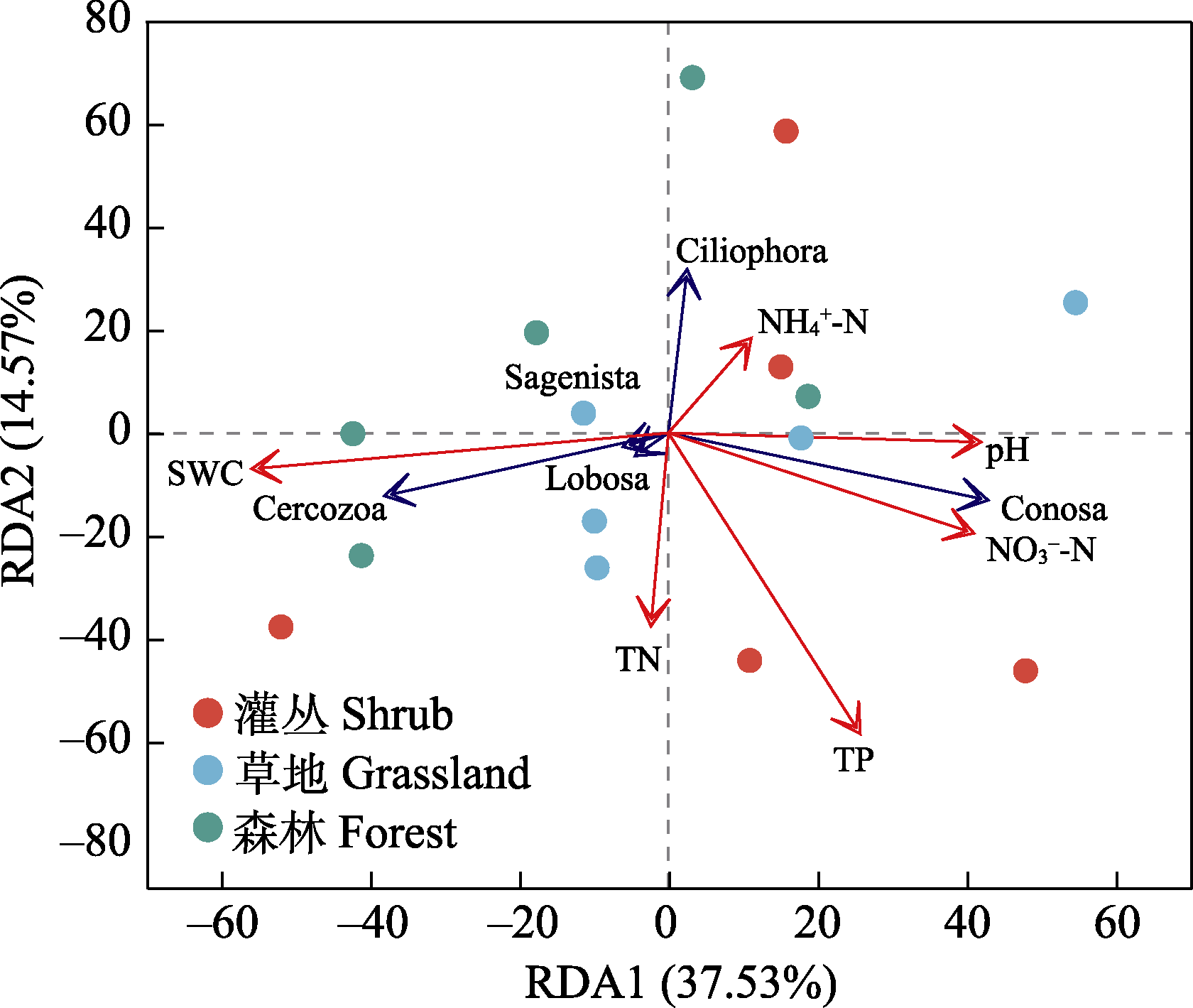
图4 不同植被类型土壤原生动物群落结构与环境因子的冗余分析。SWC: 土壤含水量; TC: 总碳; TN: 总氮; TP: 总磷; NO3--N: 硝态氮; NH4+-N: 铵态氮。Cercozoa: 丝足虫门; Conosa: 锥足亚门; Ciliophora: 纤毛虫门; Lobosa: 叶足亚门; Sagenista: 网体虫门。红色线条代表环境因子, 蓝色线条代表优势原生动物门。
Fig. 4 Redundancy analysis of soil protozoan community structure and environmental factors among different vegetation types. SWC, Soil water content; TC, Total carbon; TN, Total nitrogen; TP, Total phosphorus; NO3--N, Nitrate nitrogen; NH4+-N, Ammonium nitrogen; Red and blue lines represent environmental factors and the dominant protozoan phylum, respectively.
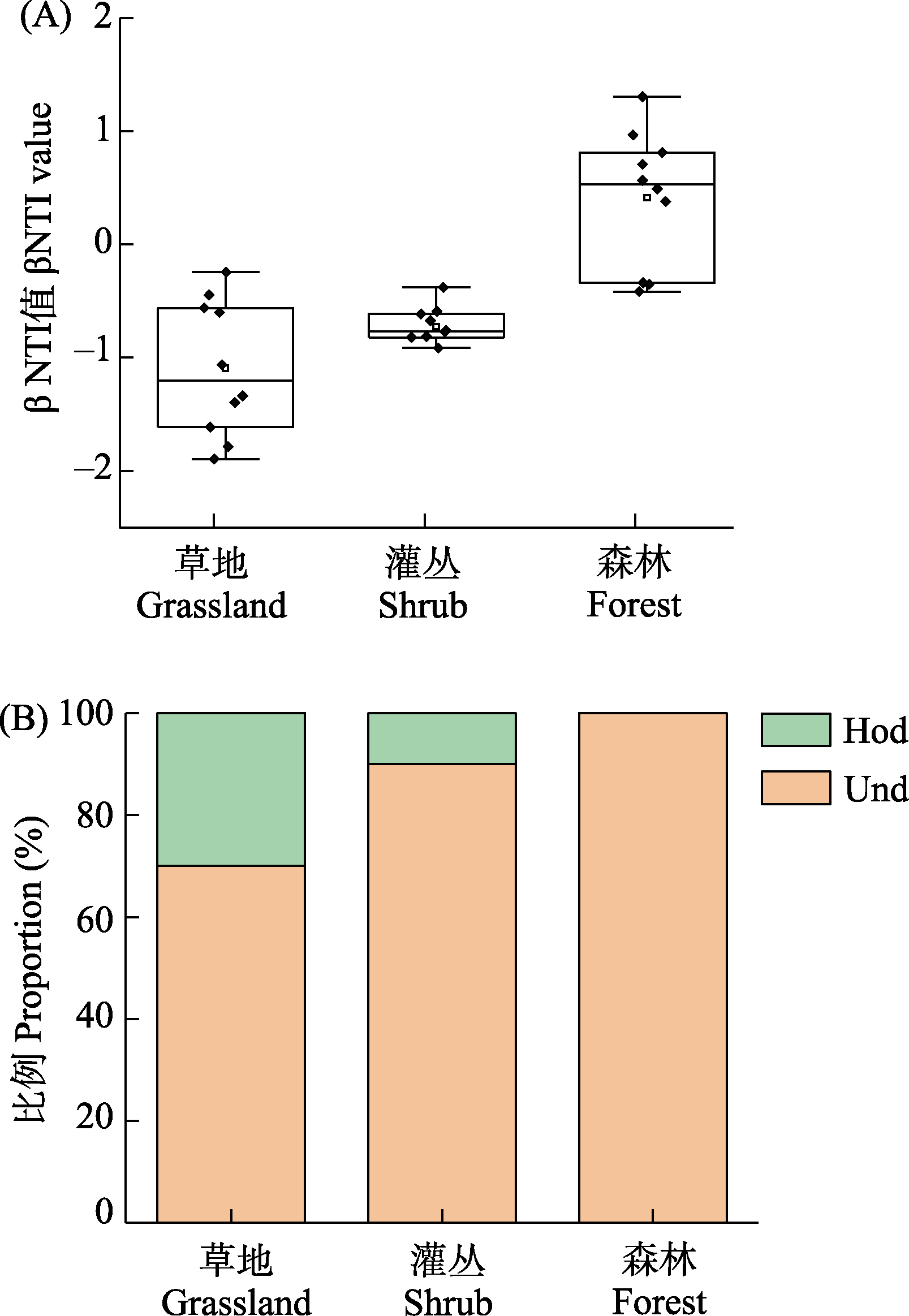
图5 不同植被类型土壤原生动物群落的βNTI值(A)和群落构建过程的比例(B)。βNTI: 最近种间亲缘关系指数; Hod: 同质性扩散; Und: 非主导过程。
Fig. 5 βNTI value of soil protozoan community in different vegetation types and the proportion of community assembly process. βNTI, β-nearest taxon index; Hod, Homogenizing dispersal; Und: Undominated processes.
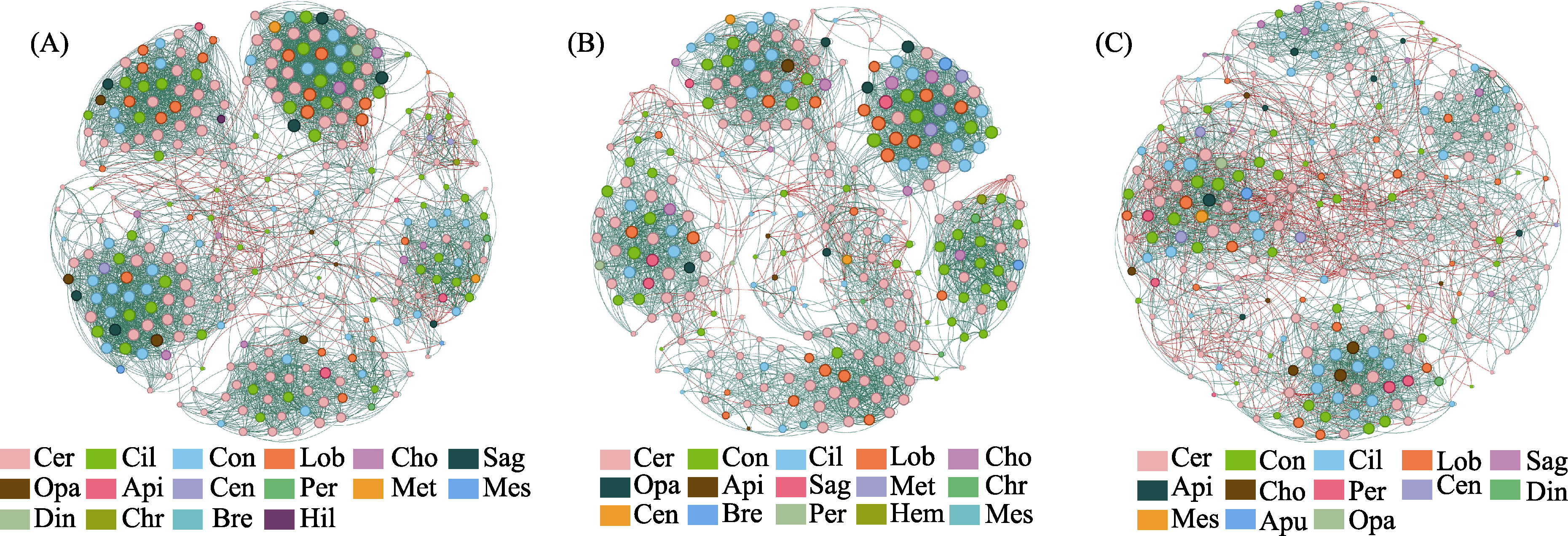
图6 不同植被类型土壤原生动物共现网络。图中一个节点代表一个科, 每一个颜色代表一个门。节点大小与丰度成正比, 有显著相关性的节点通过线连接起来, 绿色表示正相关, 红色表示负相关。(A)草地; (B)灌丛; (C)森林。Cer: 丝足虫门; Cil: 纤毛虫门; Con: 锥足亚门; Lob: 叶足亚门; Cho: 领鞭毛虫门; Sag: 网体虫门; Opa: Opalozoa; Api: 顶复门; Cen: 中阳虫门; Per: 顶复动物亚门(拍琴纲); Met: 后滴门; Mes: 中粘菌门; Din: 双鞭毛虫门; Chr: Chrompodellids; Bre: 简虫门; Hil: Hilomonadea; Hem: 半鞭毛虫门; Apu: 无根虫门。
Fig. 6 Co-occurrence network of soil protozoa in different vegetation types. A node represents a family and each colour represents a phylum. Node size is proportional to abundance, and nodes with significant correlation are connected by lines, with green indicating positive correlation and red negative correlation. (A) Grassland; (B) Shrub; (C) Forest. Cer, Cercozoa; Cil, Ciliophora; Con, Conosa; Lob, Lobosa; Cho, Choanoflagellida; Sag, Sagenista; Opa, Opalozoa; Api, Apicomplexa; Cen, Centroheliozoa; Per, Perkinsea; Met, Metamonada; Mes, Mesomycetozoa; Din, Dinoflagellata; Chr, Chrompodellids; Bre, Breviatea; Hil, Hilomonadea; Hem, Hemimastigophora; Apu, Apusomonadidae.
| 共现网络拓扑学性质 Topological properties of co-occurring networks | 草地 Grassland | 灌丛 Shrub | 森林 Forest |
|---|---|---|---|
| 节点 Nodes | 313 | 275 | 287 |
| 边数 Edges | 4,580 | 3,598 | 3,103 |
| 平均度 Average degree | 29.265 | 26.167 | 21.624 |
| 网络密度 Network density | 0.094 | 0.096 | 0.076 |
| 模块化 Modularity | 0.758 | 0.764 | 0.665 |
| 平均聚类系数 Average clustering coefficient | 0.753 | 0.774 | 0.649 |
| 平均路径长度 Average path length | 3.698 | 3.914 | 3.378 |
| 正相关关系 Positive correlation (%) | 95.09 | 94.8 | 82.57 |
| 负相关关系 Negative correlation (%) | 4.91 | 5.2 | 17.43 |
表4 土壤原生动物群落分子生态网络图的拓扑学属性
Table 4 Topological properties of molecular ecological network diagram of soil protozoan communities
| 共现网络拓扑学性质 Topological properties of co-occurring networks | 草地 Grassland | 灌丛 Shrub | 森林 Forest |
|---|---|---|---|
| 节点 Nodes | 313 | 275 | 287 |
| 边数 Edges | 4,580 | 3,598 | 3,103 |
| 平均度 Average degree | 29.265 | 26.167 | 21.624 |
| 网络密度 Network density | 0.094 | 0.096 | 0.076 |
| 模块化 Modularity | 0.758 | 0.764 | 0.665 |
| 平均聚类系数 Average clustering coefficient | 0.753 | 0.774 | 0.649 |
| 平均路径长度 Average path length | 3.698 | 3.914 | 3.378 |
| 正相关关系 Positive correlation (%) | 95.09 | 94.8 | 82.57 |
| 负相关关系 Negative correlation (%) | 4.91 | 5.2 | 17.43 |
| [1] | Bardgett RD, Bowman WD, Kaufmann R, Schmidt SK (2005) A temporal approach to linking aboveground and belowground ecology. Trends in Ecology & Evolution, 20, 634-641. |
| [2] | Bates ST, Clemente JC, Flores GE, Walters WA, Parfrey LW, Knight R, Fierer N (2013) Global biogeography of highly diverse protistan communities in soil. The ISME Journal, 7, 652-659. |
| [3] |
Brazeau HA, Schamp BS (2019) Examining the link between competition and negative co-occurrence patterns. Oikos, 128, 1358-1366.
DOI |
| [4] | Carr A, Diener C, Baliga NS, Gibbons SM (2019) Use and abuse of correlation analyses in microbial ecology. The ISME Journal, 13, 2647-2655. |
| [5] |
Ceja-Navarro JA, Wang Y, Ning DL, Arellano A, Ramanculova L, Yuan MM, Byer A, Craven KD, Saha MC, Brodie EL, Pett-Ridge J, Firestone MK (2021) Protist diversity and community complexity in the rhizosphere of switchgrass are dynamic as plants develop. Microbiome, 9, 96.
DOI PMID |
| [6] | Chase JM, Myers JA (2011) Disentangling the importance of ecological niches from stochastic processes across scales. Philosophical Transactions of the Royal Society B: Biological Sciences, 366, 2351-2363. |
| [7] | Che RX, Wang SP, Wang YF, Xu ZH, Wang WJ, Rui YC, Wang F, Hu JM, Tao J, Cui XY (2019) Total and active soil fungal community profiles were significantly altered by six years of warming but not by grazing. Soil Biology and Biochemistry, 139, 107611. |
| [8] | Chen RR, Zhang JW, Dong Y, Lin XG, Feng YZ (2021) Effects of salinity on soil bacterial diversity and assembly processes in coastal soils. Chinese Journal of Applied Ecology, 32, 1816-1824. (in Chinese with English abstract) |
|
[陈瑞蕊, 张建伟, 董洋, 林先贵, 冯有智 (2021) 盐度对滨海土壤细菌多样性和群落构建过程的影响. 应用生态学报, 32, 1816-1824.]
DOI |
|
| [9] |
Chen YL, Yang X, Fu W, Chen BD, Hu HW, Feng K, Geisen S (2022) Conversion of natural grassland to cropland alters microbial community assembly across Northern China. Environmental Microbiology, 24, 5630-5642.
DOI PMID |
| [10] | Chen ZH, Liang X, Li YC, Li YF, Xu QF, Wu QF, Li SH, Shen ZM (2017) Effects of different fertilization regimes on soil fungal communities under Phyllostachys violascens stand. Chinese Journal of Applied Ecology, 28, 1168-1176. (in Chinese with English abstract) |
|
[陈志豪, 梁雪, 李永春, 李永夫, 徐秋芳, 邬奇峰, 李松昊, 沈振明 (2017) 不同施肥模式对雷竹林土壤真菌群落特征的影响. 应用生态学报, 28, 1168-1176.]
DOI |
|
| [11] |
Du XF, Deng Y, Li SZ, Escalas A, Feng K, He Q, Wang ZJ, Wu YN, Wang DR, Peng X, Wang S (2021) Steeper spatial scaling patterns of subsoil microbiota are shaped by deterministic assembly process. Molecular Ecology, 30, 1072-1085.
DOI PMID |
| [12] |
Fiore-Donno AM, Richter-Heitmann T, Bonkowski M (2020) Contrasting responses of protistan plant parasites and phagotrophs to ecosystems, land management and soil properties. Frontiers in Microbiology, 11, 1823.
DOI PMID |
| [13] |
Geisen S, Mitchell EAD, Adl S, Bonkowski M, Dunthorn M, Ekelund F, Fernández LD, Jousset A, Krashevska V, Singer D, Spiegel FW, Walochnik J, Lara E (2018) Soil protists: A fertile frontier in soil biology research. FEMS Microbiology Reviews, 42, 293-323.
DOI PMID |
| [14] |
Geisen S, Xiong W, Song Y, Yang K, Shen Q (2020) Rhizosphere protists are key determinants of plant health. Microbiome, 8, 27.
DOI PMID |
| [15] | Grossmann L, Jensen M, Heider D, Jost S, Glücksman E, Hartikainen H, Mahamdallie SS, Gardner M, Hoffmann D, Bass D, Boenigk J (2016) Protistan community analysis: Key findings of a large-scale molecular sampling. The ISME Journal, 10, 2269-2279. |
| [16] | Grujcic V, Nuy JK, Salcher MM, Shabarova T, Kasalicky V, Boenigk J, Jensen M, Simek K (2018) Cryptophyta as major bacterivores in freshwater summer plankton. The ISME Journal, 12, 1668-1681. |
| [17] |
Guo H, Mao ZQ, Liu XL (2011) Research progress of interaction between plant and microorganism. Chinese Agricultural Science Bulletin, 27(9), 28-33. (in Chinese with English abstract)
DOI |
| [国辉, 毛志泉, 刘训理 (2011) 植物与微生物互作的研究进展. 中国农学通报, 27(9), 28-33.] | |
| [18] | Han DX, Wang N, Sun X, Hu YB, Feng FJ (2018) Biogeo- graphical distribution of bacterial communities in Changbai Mountain, Northeast China. Microbiology Open, 7, e00529. |
| [19] |
Howe AT, Bass D, Vickerman K, Chao EE, Cavalier-Smith T (2009) Phylogeny, taxonomy, and astounding genetic diversity of Glissomonadida ord. nov., the dominant gliding zooflagellates in soil (Protozoa: Cercozoa). Protist, 160, 159-189.
DOI PMID |
| [20] | Islam W, Saqib HSA, Tayyab M, Wang ZY, Ding XX, Su XP, Huang ZQ, Chen HYH (2022) Natural forest chrono- sequence maintains better soil fertility indicators and assemblage of total belowground soil biota than Chinese fir monoculture in subtropical ecosystem. Journal of Cleaner Production, 334, 130228. |
| [21] | Jia T, Liang XX, Guo TY, Wu TH, Chai BF (2022) Bacterial community succession and influencing factors for Imperata cylindrica litter decomposition in a copper tailings area of China. Science of the Total Environment, 815, 152908. |
| [22] | Liang GH, Wu JP, Xiong X, Wu XY, Chu GW, Zhou GY, Zeng RS, Zhang DQ (2015) Responses of soil pH value and soil microbial biomass carbon and nitrogen to simulated acid rain in three successional subtropical forests at Dinghushan nature reserve. Ecology and Environmental Sciences, 24, 911-918. (in Chinese with English abstract) |
|
[梁国华, 吴建平, 熊鑫, 吴小映, 褚国伟, 周国逸, 曾任森, 张德强 (2015) 鼎湖山不同演替阶段森林土壤pH值和土壤微生物量碳氮对模拟酸雨的响应. 生态环境学报, 24, 911-918.]
DOI |
|
| [23] | Lin CY, Li XL, Zhang YX, Sun HF, Li CY, Jin LQ, Yang XG, Liu K (2021) Responses of different degradation stages of alpine wetland on soil microbial community in the Yellow River source zone. Environmental Science, 42, 3971-3984. (in Chinese with English abstract) |
| [林春英, 李希来, 张玉欣, 孙华方, 李成一, 金立群, 杨鑫光, 刘凯 (2021) 黄河源区高寒沼泽湿地土壤微生物群落结构对不同退化的响应. 环境科学, 42, 3971-3984.] | |
| [24] | Luo ZM, Liu JX, Zhou YY, Du JQ, Wu Q, Chai BF (2021) Community structures and diversity patterns of the soil protist communities along an altitudinal gradient in a subalpine grassland. Acta Ecologica Sinica, 41, 2783-2793. (in Chinese with English abstract) |
| [罗正明, 刘晋仙, 周妍英, 杜京旗, 吴强, 柴宝峰 (2021) 亚高山草地土壤原生生物群落结构和多样性海拔分布格局. 生态学报, 41, 2783-2793.] | |
| [25] | Meira BR, Lansac-Toha FM, Segovia BT, Buosi PRB, Lansac-Tôha FA, Velho LFM (2018) The importance of herbivory by protists in lakes of a tropical floodplain system. Aquatic Ecology, 52, 193-210. |
| [26] |
Mo YY, Peng F, Gao XF, Xiao P, Logares R, Jeppesen E, Ren KX, Xue YY, Yang J (2021) Low shifts in salinity determined assembly processes and network stability of microeukaryotic plankton communities in a subtropical urban reservoir. Microbiome, 9, 128.
DOI PMID |
| [27] |
Niu KC, Liu YN, Shen ZH, He FL, Fang JY (2009) Community assembly: The relative importance of neutral theory and niche theory. Biodiversity Science, 17, 579-593. (in Chinese with English abstract)
DOI |
|
[牛克昌, 刘怿宁, 沈泽昊, 何芳良, 方精云 (2009) 群落构建的中性理论和生态位理论. 生物多样性, 17, 579-593.]
DOI |
|
| [28] | Ren QR, Mao XY, Qi XJ, Liu JX, Jia T, Wu TH, Chai BF (2023) Distribution patterns and driving mechanism of soil protozoan community at the different depths of Larix principis-chinensis forest in the Luya Mountain, China. Chinese Journal of Applied Ecology, 34, 1395-1403. (in Chinese with English abstract) |
|
[任倩茹, 毛晓雅, 齐晓君, 刘晋仙, 贾彤, 吴铁航, 柴宝峰 (2023) 芦芽山华北落叶松林不同深度土壤原生动物群落分布格局及驱动机制. 应用生态学报, 34, 1395-1403.]
DOI |
|
| [29] | Salmeron R, García CB, García J (2018) Variance inflation factor and condition number in multiple linear regression. Journal of statistical computation and simulation. Journal of Statistical Computation and Simulation, 88, 2365-2384. |
| [30] | Schimel JP, Gulledge JM, Clein-Curley JS, Lindstrom JE, Braddock JF (1999) Moisture effects on microbial activity and community structure in decomposing birch litter in the Alaskan taiga. Soil Biology and Biochemistry, 31, 831-838. |
| [31] |
Shi Y, Li YT, Xiang XJ, Sun RB, Yang T, He D, Zhang KP, Ni YY, Zhu YG, Adams JM, Chu HY (2018) Spatial scale affects the relative role of stochasticity versus determinism in soil bacterial communities in wheat fields across the North China Plain. Microbiome, 6, 27.
DOI PMID |
| [32] | Stegen JC, Lin XJ, Fredrickson JK, Chen XY, Kennedy DW, Murray CJ, Rockhold ML, Konopka A (2013) Quantifying community assembly processes and identifying features that impose them. The ISME Journal, 7, 2069-2079. |
| [33] | Stegen JC, Lin XJ, Konopka AE, Fredrickson JK (2012) Stochastic and deterministic assembly processes in subsurface microbial communities. The ISME Journal, 6, 1653-1664. |
| [34] | Wang C, Li YF, Xu RL (2017) Comparative study on community structure of Sarcodina in soils under different vegetations in the Dinghu Mountain. Soils, 49, 580-587. (in Chinese with English abstract) |
| [王超, 李亚芳, 徐润林 (2017) 鼎湖山不同植被类型下土壤肉足虫群落结构的比较研究. 土壤, 49, 580-587.] | |
| [35] | Wang XR, Zheng MY, Zhang Y, Chen Y, Zhao LJ, Chai BF, Jia T (2023) Stoichiometric soil microbial and enzymatic characteristics under three different plantation types in China’s Luya Mountain. Forests, 14, 558. |
| [36] | Wang Y, Ding GD, Liu MJ, Gao GL, Yu MH, Li X (2022) Influence of different vegetation types on soil microbial characteristics of typical forest land in Yulin sandy area. Chinese Journal of Soil Science, 53, 907-918. (in Chinese with English abstract) |
| [王岳, 丁国栋, 刘梦婕, 高广磊, 于明含, 李旭 (2022) 榆林沙区典型林地不同植被类型对土壤微生物群落结构的影响. 土壤通报, 53, 907-918.] | |
| [37] | Wang Z, Liu Y, Wang F, Wang YC (2023) Effects of vegetation types and seasonal dynamics on the diversity and function of soil bacterial communities in the upper reaches of the Heihe River. Environmental Science, 44, 6339-6353. (in Chinese with English abstract) |
| [王竹, 刘扬, 王芳, 王义成 (2023) 黑河上游不同植被类型土壤细菌群落多样性、功能及季节动态. 环境科学, 44, 6339-6353.] | |
| [38] |
Wu LK, Lin XM, Lin WX (2014) Advances and perspective in research on plant-soil-microbe interactions mediated by root exudates. Chinese Journal of Plant Ecology, 38, 298-310. (in Chinese with English abstract)
DOI |
|
[吴林坤, 林向民, 林文雄 (2014) 根系分泌物介导下植物-土壤-微生物互作关系研究进展与展望. 植物生态学报, 38, 298-310.]
DOI |
|
| [39] | Wu XG, Guo JP, Yang XY, Tian XP (2011) Soil organic carbon storage and profile inventory in the different vegetation types of Luya Mountain. Acta Ecologica Sinica, 31, 3009-3019. (in Chinese with English abstract) |
| [武小钢, 郭晋平, 杨秀云, 田旭平 (2011) 芦芽山典型植被土壤有机碳剖面分布特征及碳储量. 生态学报, 31, 3009-3019.] | |
| [40] | Xiong W, Jousset A, Li R, Delgado-Baquerizo M, Bahram M, Logares R, Wilden B, de Groot GA, Amacker N, Kowalchuk GA, Shen QR, Geisen S (2021) A global overview of the trophic structure within microbiomes across ecosystems. Environment International, 151, 106438. |
| [41] | Zhang K, Zuo XY, Hu YL, Yue MY, Lü XC, Yao JY, Yang JY (2022) Community structure of soil fauna of different vegetation types in Saihanba. Forestry and Ecological Sciences, 37, 223-237. (in Chinese with English abstract) |
| [张珂, 左鑫钰, 胡娅丽, 岳妹颖, 吕晓翠, 姚巨云, 杨晋宇 (2022) 塞罕坝不同植被类型地表土壤动物群落特征. 林业与生态科学, 37, 223-237.] | |
| [42] | Zhang W, Zhang H (2008) Spacial distribution characteristics of soil active organic carbon in three alpine meadows in eastern Qinghai-Tibetan Plateau. Journal of Mountain Science, 26, 205-211. (in Chinese with English abstract) |
| [张伟, 张宏 (2008) 青藏高原东缘红原地区三种不同草甸土壤活性碳特征. 山地学报, 26, 205-211.] |
| [1] | 曲锐, 左振君, 王有鑫, 张良键, 吴志刚, 乔秀娟, 王忠. 基于元素组的生物地球化学生态位及其在不同生态系统中的应用[J]. 生物多样性, 2024, 32(4): 23378-. |
| [2] | 李斌, 宋鹏飞, 顾海峰, 徐波, 刘道鑫, 江峰, 梁程博, 张萌, 高红梅, 蔡振媛, 张同作. 昆仑山青海片区鸟类群落多样性格局及其驱动因素[J]. 生物多样性, 2024, 32(4): 23406-. |
| [3] | 徐凯伦, 陈小荣, 张敏华, 于婉婉, 吴素美, 朱志成, 陈定云, 兰荣光, 董舒, 刘宇. 演替和地形共同影响浙江百山祖森林群落的性系统多样性[J]. 生物多样性, 2024, 32(12): 24338-. |
| [4] | 杨舒涵, 王贺, 陈磊, 廖蓥飞, 严光, 伍一宁, 邹红菲. 松嫩平原异质生境对土壤线虫群落特征的影响[J]. 生物多样性, 2024, 32(1): 23295-. |
| [5] | 段晓敏, 李佳佳, 李靖宇, 李艳楠, 袁存霞, 王英娜, 刘建利. 腾格里沙漠东南缘藓结皮植物-土壤连续体不同粒径土壤微生物群落多样性[J]. 生物多样性, 2023, 31(9): 23131-. |
| [6] | 张雅丽, 张丙昌, 赵康, 李凯凯, 刘燕晋. 毛乌素沙地不同类型生物结皮细菌群落差异及其驱动因子[J]. 生物多样性, 2023, 31(8): 23027-. |
| [7] | 杨胜娴, 杨清, 李晓东, 巢欣, 刘惠秋, 魏蓝若雪, 巴桑. 确定性过程主导高原典型河流浮游植物地理分布格局和群落构建[J]. 生物多样性, 2023, 31(7): 23092-. |
| [8] | 杨清, 李晓东, 杨胜娴, 巢欣, 刘惠秋, 巴桑. 雅鲁藏布江中游丰水期原生动物群落多样性及其影响因子[J]. 生物多样性, 2023, 31(4): 22500-. |
| [9] | 桑佳文, 宋创业, 贾宁霞, 贾元, 刘长成, 乔鲜果, 张琳, 袁伟影, 吴冬秀, 李凌浩, 郭柯. 青藏高原植被调查与制图评估[J]. 生物多样性, 2023, 31(3): 22430-. |
| [10] | 杜芳, 荣晓莹, 徐鹏, 尹本丰, 张元明. 降水对古尔班通古特沙漠细菌群落多样性和构建过程的影响[J]. 生物多样性, 2023, 31(2): 22492-. |
| [11] | 董建宇, 孙昕, 詹启鹏, 张宇洋, 张秀梅. 莱州湾东岸潮下带大型底栖动物群落beta多样性格局及其驱动因素[J]. 生物多样性, 2022, 30(3): 21388-. |
| [12] | 王寅, 王健铭, 曲梦君, 李景文. 干旱内陆河流域植物群落构建过程及其关键驱动因素[J]. 生物多样性, 2022, 30(2): 21419-. |
| [13] | 刘厶瑶, 李柱, 柯欣, 孙丽娜, 吴龙华, 赵杰杰. 贵州省典型汞铊矿区周边农田土壤跳虫群落特征[J]. 生物多样性, 2022, 30(12): 22265-. |
| [14] | 雍青措姆, 习新强, 牛克昌. 高寒草甸植物物种丧失对草原毛虫的影响[J]. 生物多样性, 2022, 30(11): 22069-. |
| [15] | 米湘成, 王绪高, 沈国春, 刘徐兵, 宋晓阳, 乔秀娟, 冯刚, 杨洁, 毛子昆, 徐学红, 马克平. 中国森林生物多样性监测网络: 二十年群落构建机制探索的回顾与展望[J]. 生物多样性, 2022, 30(10): 22504-. |
| 阅读次数 | ||||||
|
全文 |
|
|||||
|
摘要 |
|
|||||
备案号:京ICP备16067583号-7
Copyright © 2022 版权所有 《生物多样性》编辑部
地址: 北京香山南辛村20号, 邮编:100093
电话: 010-62836137, 62836665 E-mail: biodiversity@ibcas.ac.cn